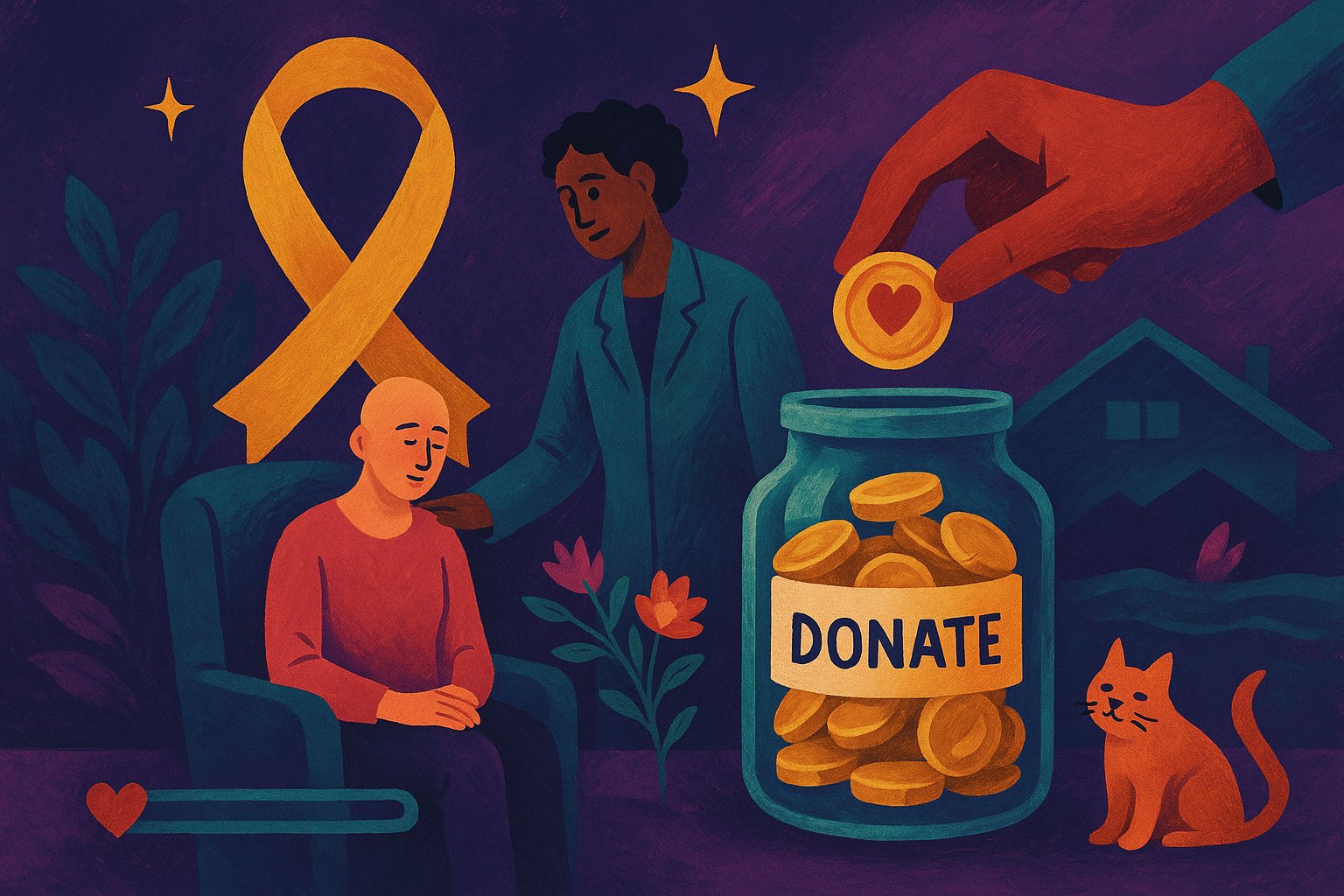Lighting the Path to Accessible Mental Health Care
In an era where mental health has finally emerged from the shadows, countless individuals still struggle to access the treatment they desperately need. From therapy sessions and psychiatric consultations to medications and residential programs, the costs can quickly accumulate, leaving many unable to obtain timely care. Mental health treatment crowdfunding has become a vital lifeline, enabling people to share their stories and appeal directly to compassionate supporters. Yet, launching a successful campaign demands more than simply posting a plea online. It requires strategic storytelling, transparent financial planning, and a deep understanding of donor psychology. This article explores creative, professional tactics for getting donors to care—and to contribute—so that every individual seeking mental health support can turn the corner toward recovery.
Breaking Down Barriers: Empathy Over Stigma
One of the most significant hurdles in mental health crowdfunding is overcoming societal stigma. Prospective donors may hold misconceptions—believing mental health challenges are less “real” than physical ailments, or assuming individuals should “just pull themselves up by their bootstraps.” To build empathy, campaigns must humanize the experience of mental health treatment. Begin by framing the narrative in a way that underscores the universality of emotional struggle: many of us experience anxiety, depression, or trauma at some point in our lives. Use relatable language that keeps the tone hopeful rather than despairing. Paint a picture of what daily life looks like for someone grappling with untreated mental illness—frequent panic attacks that make commuting to work unbearable, or depression so deep that even basic self-care feels insurmountable.
Highlight research-backed facts to reinforce the validity of mental health concerns. For instance, cite statistics showing that one in five adults in the United States lives with a mental health condition, or reference studies demonstrating the effectiveness of evidence-based therapies. By weaving these figures into the campaign’s introductory narrative, you signal to donors that mental health care is not a niche cause but a pressing societal issue. Balancing personal anecdotes with credible data helps dismantle stereotypes and establishes the campaign’s credibility. When donors recognize that they are supporting a cause grounded in both human experience and scientific evidence, they become more willing to engage—and to give generously.
Weaving Your Personal Journey into a Resonant Narrative
At the heart of every successful crowdfunding campaign lies a story that forges an emotional connection between the donor and the individual in need. A compelling mental health crowdfunding narrative delves into the person’s journey: when symptoms first emerged, how they sought help, and the roadblocks encountered—be it long waitlists, insurance denials, or prohibitive out-of-pocket costs. Instead of focusing solely on clinical terminology, describe real-life moments: the sleepless nights spent battling intrusive thoughts, the overwhelming relief of opening up to a therapist for the first time, or the fear of depleting savings just to cover a handful of psychiatry appointments.
Maintain authenticity by using a conversational yet professional tone, allowing prospective donors to feel they are sitting across from someone brave enough to share their vulnerabilities. Include direct quotes from the individual or from close friends and family members who can attest to the positive changes that therapy or medication has already provided. If possible, share brief video snippets—no more than two minutes—that capture genuine emotion: a tearful gratitude, a tentative smile, or a voice quivering with hope. Videos increase shareability on social media platforms and amplify the narrative’s impact. By weaving personal anecdotes with moments of resilience and gratitude, you transform an abstract fundraising plea into a vivid, relatable story—one that motivates donors to become invested in the individual’s recovery journey.
Mapping Out Treatment Needs with Clear Financial Transparency
Donors need reassurance that their contributions will be used judiciously and effectively. To establish this trust, break down the total fundraising goal into specific treatment expenses. For example, itemize costs such as a 12-week Cognitive Behavioral Therapy (CBT) program at $150 per session, a three-month prescription of generic antidepressants at $40 per month, and emergency psychiatric evaluation at $250. If your goal includes higher-level care—such as inpatient residential treatment or an intensive outpatient program—list those costs separately: “Our goal includes $12,000 for a 30-day residential program tailored to dual-diagnosis treatment.” Whenever possible, attach or link to official invoices, clinic brochures, or physician letters that verify these estimates. Transparency eliminates uncertainty and sends a clear message: donors are not sending money into a void but fueling a concrete, actionable treatment plan.
In the campaign’s main body, intersperse these cost breakdowns with narrative context, ensuring that donors understand why each expense is critical. For instance, explain how uninterrupted therapy sessions reduce the risk of relapse or how consistent medication adherence stabilizes mood and prevents emergency room visits. When expenses escalate—perhaps due to sliding-scale fee caps or co-pays—acknowledge these variables candidly, showing that you’ve considered all financial contingencies. Additionally, outline how excess funds will be managed: whether they’ll support follow-up maintenance appointments, subsidize transportation to and from clinics, or seed future mental health advocacy efforts. By mapping out treatment needs with full financial clarity, you foster donor confidence, encouraging larger and more frequent gifts.
Amplifying Your Cause Through Strategic Digital Outreach
To maximize reach, campaigns must be optimized for search engines and social media channels. Start by selecting a keyword-rich campaign title—such as “Help Emily Access Life-Changing Depression Treatment” or “Support John’s Bipolar Disorder Therapy Fund.” Keywords like “mental health crowdfunding,” “therapy costs,” and “depression treatment fund” not only convey immediate relevance but also boost search engine visibility. Within the campaign description, integrate secondary keywords seamlessly: “psychotherapy,” “psychiatrist,” “medication assistance,” and “mental wellness support.” Avoid excessive repetition; instead, weave these terms into a flowing narrative that feels natural to read.
Social media promotion is equally vital. Identify relevant platforms—Facebook for community groups, Instagram for visual storytelling, Twitter for real-time updates, and LinkedIn for professional networks. Create platform-specific content: on Facebook, craft a succinct post featuring a poignant excerpt from the campaign’s narrative and a link to donate; on Instagram, share a carousel of images showing moments of progress—such as a snapshot of a self-care journal or a photo of a healing meditation space—with concise captions that include key hashtags like #MentalHealthCrowdfunding, #TherapySavesLives, and #BreakTheStigma. Utilize Instagram Stories to post short, daily updates: “Day 7: Completed our first CBT session—feeling cautiously optimistic!” Tag friends, mental health advocates, and community leaders who can help amplify the message.
Invest in minimal paid advertising to stretch your reach: a $20 Facebook campaign targeting users interested in mental health awareness within a 50-mile radius can translate into hundreds of website clicks and potential donors. Likewise, consider a small sponsored post on Instagram or Twitter to hone in on demographics—such as ages 25–45, urban areas, and those who follow mental health influencers. By combining SEO-friendly copy with a targeted social media blueprint, your campaign can break through the noise, drawing in donors who may not have direct personal ties but share a genuine passion for supporting mental health initiatives.
Cultivating Donor Trust with Ongoing Engagement
Winning donor support is only half the battle; sustaining engagement over time is equally crucial. Mental health treatment often spans months or even years, and many campaigns extend far beyond their initial fundraising window. To keep donors invested, schedule regular, substantive progress updates. Rather than posting dry financial tallies, share emotionally resonant milestones: “This week, Emily celebrated her first month of consistent therapy. She’s learning coping skills that help her navigate triggers without spiraling into panic.” Accompany these updates with photos—when appropriate and with permission—or brief video diaries. Authenticity remains the guiding principle: if Emily is comfortable, a short clip of her describing newfound tools that help her breathe through anxiety can move donors to further support.
In each update, reference how donated funds are being applied: “Thanks to your generosity, we covered three therapy sessions this month and purchased two months’ worth of medication.” When setbacks occur—perhaps insurance hurdles delay an appointment—be transparent. Explain the situation, articulate how you plan to pivot (e.g., exploring sliding-scale clinics or telehealth options), and remind donors that mental health recovery is rarely linear. This level of candor reinforces trust. Additionally, express gratitude in personalized ways: highlight standout donor contributions (with permission) or spotlight community champions who helped spread the word. Small gestures—such as sending digital thank-you cards, naming donors on a shared “Wall of Hope,” or hosting a live-streamed Q&A where supporters can connect directly—help imbue a sense of shared purpose. By cultivating ongoing engagement, donors feel their contributions are making a dynamic difference, bolstering the campaign’s momentum and likelihood of long-term success.
Enlisting Community Allies and Professional Partners
No campaign exists in isolation. Building a network of community allies and professional partners enhances credibility and expands resource channels. Begin by identifying local mental health professionals—therapists, psychiatrists, social workers—who might be willing to offer reduced-rate services or pro bono consultations once a portion of the crowdfunding goal is reached. Present them with a clear proposal: explain Emily’s or John’s treatment needs, share the crowdfunding page link, and detail how their support could catalyze the campaign’s success. In exchange, offer to feature their practice’s logo on the campaign page and acknowledge their generosity in social media shoutouts. This reciprocal arrangement not only deepens donor confidence but also fosters a culture of collaborative care.
Community organizations—such as faith-based groups, local nonprofits, university counseling centers, or peer support networks—can amplify outreach efforts. Organize joint awareness events: a virtual panel discussion on “The Importance of Accessible Therapy” co-hosted by a local nonprofit and the campaign organizer, or a live-streamed “Mental Health Fundraiser Concert” featuring local musicians who donate their time. Partner with businesses that share a commitment to mental wellness: independent bookstores might host a “Mindfulness Book Drive,” where a percentage of sales from selected titles goes toward the crowdfunding campaign. In each collaboration, leverage the partner’s established audiences to introduce the campaign to new pools of potential donors. When community stakeholders unite—cross-promoting and pooling resources—the campaign gains momentum, transcending individual networks and galvanizing broader support.
Safeguarding Ethics, Privacy, and Sensitivity
Mental health is profoundly personal; safeguarding confidentiality and practicing sensitivity must be non-negotiable. Before publishing personal stories, secure explicit consent from the individual at the center of the campaign, ensuring they fully understand how their information will be used and shared. If the individual prefers anonymity, consider sharing their story using a pseudonym or partial narrative that highlights key emotional moments without revealing identifiable details. When featuring photographs or video clips, obtain signed releases from anyone whose image appears—family members, friends, or clinicians—respecting boundaries around traumatic experiences.
Ethical considerations extend to the campaign’s portrayal of mental health challenges. Avoid language that sensationalizes or trivializes the struggle: refrain from phrases like “plagued by demons” or “crazy unstable.” Instead, use clinical yet compassionate terms—“Jessica experienced debilitating panic attacks that disrupted her daily life” or “Mark has been diagnosed with bipolar disorder and is seeking specialized treatment.” Encourage respectful dialogue in comment sections and social media threads; establish clear guidelines to prevent stigmatizing remarks or unsolicited medical advice from derailing the conversation. By modeling empathy and discretion, you create a safe space where donors feel confident supporting an initiative that treats mental health with the seriousness and respect it deserves.
Building Bridges for Long-Term Support and Recovery
Crowdfunding for mental health treatment should never be perceived as a one-off appeal. True recovery often necessitates ongoing therapy, medication adjustments, and community support that extends well beyond initial funding. The campaign’s narrative should acknowledge this reality, setting expectations that additional fundraising phases may be necessary. Offer donors an opportunity to subscribe to periodic “Wellness Reports,” which provide updates on treatment progress, emerging challenges, and future care plans. Encourage recurring donations or monthly “sustainer” pledges—small, manageable contributions that, when aggregated, can underwrite continuing treatment needs.
Facilitate opportunities for donors to remain actively involved in the recovery journey. Organize virtual support circles—hosted over Zoom or another accessible platform—where donors can hear testimonials from the individual in treatment, engage with mental health professionals, and ask questions about best practices for community-centered mental wellness. Invite local advocacy groups to co-host these sessions, bridging the gap between individual narratives and broader systemic change. As the campaign progresses, spotlight the ripple effects of each gift: perhaps an individual transitions from intensive therapy to volunteering as a peer mentor, or begins hosting workshops on resilience in partnership with a local crisis helpline. When donors witness tangible transformations and community reintegration, they recognize that their support fosters sustainable recovery rather than temporary relief.
Inspiring a Compassionate Movement for Mental Wellness
Mental health treatment crowdfunding is more than just a practical fundraising tool—it represents a cultural shift toward empathy, destigmatization, and collective responsibility. When campaigns approach donors with authenticity, transparency, and sensitivity, they contribute to a broader movement that values mental wellness as an essential component of holistic health. To inspire this cultural momentum, conclude your campaign narrative by inviting supporters to become advocates. Encourage them to share mental health resources within their own networks, to challenge stereotypes when they encounter misinformation, and to champion policies that expand access to therapy and psychiatric care.
Celebrate every milestone—no matter how small—as a collective victory. When the first donation arrives, post a heartfelt acknowledgment: “Thank you, Sarah, for your $20 gift. Your support just covered one therapy session.” When therapy wheels start turning toward positive change, share the story: “Emily just completed her fourth CBT session and reports significant relief in managing intrusive thoughts.” By emphasizing that each contribution, share, or word of encouragement accelerates meaningful progress, you transform passive empathy into active engagement. As donors witness the enduring impact of their generosity, they become ambassadors for mental health, ensuring that the campaign’s legacy transcends any individual’s treatment and ripples outward—fostering communities that refuse to leave anyone behind in the journey toward emotional well-being.




